
Research Article
Adv Res Text Eng. 2016; 1(1): 1006.
Smart Textile with Stress Control Function
Kumar B*
Institute of Textiles and Clothing, The Hong Kong Polytechnic University, Hong Kong
*Corresponding author: Bipin Kumar, Institute of Textiles and Clothing, The Hong Kong Polytechnic University, Hong Kong
Received: October 01, 2016; Accepted: November 17, 2016; Published: December 02, 2016
Abstract
Since their inception, textiles have been important in human history and significantly impacted the economic development and global trade. Although they are more popular as clothing serving two main attributes - aesthetics and protection. However, with the rapidly changing needs of consumers over a few decades, smart textiles are now generating creative and novel solutions for many engineering and medical problems. With the help of new discoveries and innovative researches, they can provide many smart functions such as colour change, temperature change, shape control, super-hydrophobicity etc. In this work, a new intelligent function, i.e. stress control, in the textile will be introduced. This novel function of stress control allows programming and storing the internal stress in the structure of textile, and also enabling it to retrieve the stored stress reversibly with an external stimulus such as heat. The paper addresses the fundamentals of stress control and the related mechanism using a viscoelastic model consists of spring and dashpot elements. As an example of the potential application, the stress control in textile can be used for smart medical compression treatment to allow pressure control for an efficient treatment of compression therapy used in chronic venous disorders. It is anticipated that the research into stress control in textiles will grow in multiple dimensions as a result of their promising potential in many stress controlling applications such as pressure garments, bandages, massage devices, 3D mattress, sensors/actuators, etc.
Keywords: Smart textile; Stress control; Shape memory polymer; Pressure garments; Stimulus responsive; Compression therapy
Introduction
The demand of consumer is changing rapidly in this twenty first century, and textile are now expected to serve many other functions not just only aesthetics and protection. In this regard, the use of smart textiles has received significant attention across the globe to meet up the high expectation and provide novel technological solutions to challenging real-life problems. With the help of research and development in last two decades, many smart functions such as photochromism [1], temperature control [2], shape memory [3], super-hydrophobicity [4], auxetic [5], super conductivity [6], etc., are successfully achieved using textile substrates. These smart functions enable the textile to serve the specific demand for the application of interest. No doubt, smart textiles is an emerging research platform of this century which offers new generations of advanced fiber assemblies that could have the potential to offer unique solutions to many untouched scientific and technological challenges.
This work explores the possibility of introducing a new smart function, i.e. stress control, in the textile structure [7]. Stress is the measure of internal force between the particles inside the material body. When the material is stretched or deformed by the application of external force then the internal stresses is developed in the structure as a reaction to external force. In case of elastic material, the removal of external force or constraint causes the dissipation of the internal stresses, and the body moves to the original position. Nevertheless, the dissipation of the stress in the deformed material could also be achieved by an alternative method using external stimulus to freeze the stress without the release of external constraint [8]. Such behaviour is shown in the memory polymer network which shows freezing or releasing of the stress in the structure under constraint deformation. Because of the stress freezing in the deformed state, the memory polymer network allows shape fixing to temporarily fix the deformed shape. Once this temporary fixed shape is activated using external stimulus, e.g. heat, the frozen stress in the structure is released which push the material to go back to its original state in the absence of external constraint, this is called shape recovery. This shape control ability of the memory polymer permits programming or fixing of different deformed shapes from an original (permanent) shape, and simultaneously allows the shape recovery to the original shape. This attribute is called shape memory effect [9]. Similar to this shape memory, such memory polymer networks also demonstrate stress control ability in the structure to program different stress levels by external activation.
The function of stress control in a textile fabric could be achieved if the memory polymer filament is incorporated the structure [10- 12]. Using suitable activation programming, the memory filaments could be programmed for stress modulation in the fabric. The stress control could have significant potential in many application areas such as pressure garments, bandages, stockings, massage devices, etc. As an example, the compression bandage or stocking is used to apply pressure to limb surface [13-15]. The pressure depends on the internal stress developed in the bandage fabric upon application. The conventional bandages do not allow external pressure change as the stress in the fabric is fixed after its application on the limb. If there is possibility of stress control in the fabric, then this will allow pressure control externally by using heat stimulus. No doubt, this stress control ability should be investigated further for the detailed understanding and exploiting its smart potential applications.
Materials and Methods
Polymer
The demonstration of stress control was done on memory polymer network based on segmented polyurethane network. The polymer was synthesized using PCL (Polycaprolactone diols, Mn: 4000), and MDI (4,4′-diphenyl methanediisocyanate) and BDO (1,4-butanediol). Other polymer composition, i.e. polytetramethylene ether glycol (PTMEG; Mn = 650; Aldrich Chemical Company, USA) as soft segment, and 4,4’-methylene diphenyl diisocyanate (MDI; Aldrich Chemical Company, USA) and 1,4-butanediol (BDO; Acros Organics) as hard segment, was also prepared and examined. More detailed information on the polymer synthesis and characterization could be found in the earlier publication [7,12]. The glass transition was around 400C as measured from the dynamic mechanical analysis [12].
Filament synthesis
The polymer chips were prepared for filament development using melt spinning process [12]. For melt spinning, the polymer chips were dried at 1000C for 24 hr and the filament was spun through single extruder. The working temperature during spinning was set around 2000C. The extruded filaments from the spinneret holes were finally wound on a package at the winding speed of 500 m/min. The linear density of the memory filament was 18.6 tex.
Fabric sample production
The developed filament was then used for knitting fabric samples. Some tubular fabrics were prepared on weft knitting circular machine [10]. The machine gauge was 21 needles per inch. In addition to memory filament (18.6 tex), nylon (18.9 tex) was also fed simultaneously for the knitting. The thread densities of the fabric were 12 wales/cm and 27 courses/cm. The areal density of the fabric was 310 g/m2. The circumference and thickness of the fabric tube was 22.2 cm and 0.76 mm respectively.
Stress memory test of the polymer film
For the stress control test, an Instron with a controlled temperature chamber was used. The thermo-mechanical process involved the following steps (Figure 1): [1] Stretching of the specimen to a fixed strain at higher temperature (T>Ttrans: Transition temperature); [2] Relaxing the specimen under constraint at high temperature; [3] Cooling the specimen below the Ttrans. The above steps allowed freezing the stress in the polymer. For releasing the stress, the specimen is further activated under constraint to higher temperature [7]. The tensile load during the cycle was measured using the load cell attached to the Instron grip. The thickness of the different film specimens was in the range of 0.4 to 0.5 mm. The film was cut into strips of 1 cm width for performing stress memory tests. The gauge length of the specimen was 5 cm.
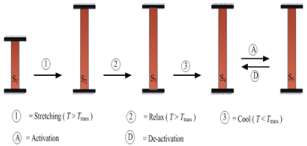
Figure 1: Programming of the memory polymer for stress control application.
Stress memory test of the fabric samples
For the fabric testing, a specimen size of 150 mm length and 50 mm in width was cut along the circumference of the stocking. The specimen gauge length was 10 cm. The thickness of the specimen was 0.76 mm. The variation in the tensile stress was obtained for the different levels of temperature (30, 40 and 50ºC) and strains (6,12 and 18%) that were selected for the pressure measurement. The stress response in the temperature range from 23°C to 50°C was observed.
Results and Discussion
Using the above programming method (Figure 1), the stress in the memory polymer was freezed, and the specimen was further activated to release the stored stress. Figure 2(I) shows the corresponding stress response during the whole process. As shown, the programming steps (1→3) involves stretching, relaxing and cooling of the specimen which finally results in stress freezing in the polymer at lower temperature (~23°C). The freezed stress was further recovered under constraint upon activating the specimen using heat stimulus. For the activation of the recovery stress, the temperature was increased using the heat source in the controlled chamber. Nevertheless, the polymer also allowed restoring or freezing the stress by cooling down to lower temperature. The temperature variation around the transition temperature was allowing the polymer to activate or deactivate the stress. This cyclic stress variation was examined for many consecutive cycles, and a consistent and robust performance was observed without any loss in the stress value (Figure 2(II)). Different values of stress could be programmed by controlling the temperature and strain levels. More stress was found at higher temperature and strain levels (Figure 2(III) and 2(IV)). Similar results are also found for the memory fabric samples where the recovery stress is increasing with increasing activation temperatures and strains (Figure 3).
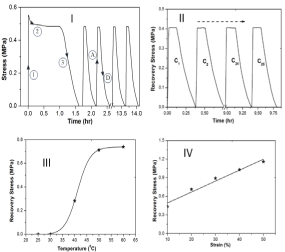
Figure 2: (I) Stress response of the memory polymer during the thermomechanical
cycle (Figure 1); (II) Cyclic stress response of the programmed
sample; (III) Recovery stress at different temperatures; (IV) Recovery stress
at different programming strains.
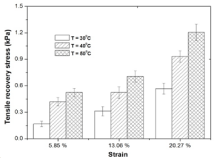
Figure 3: Results of recovery stress for memory fabric at different levels of
temperature and strains.
The nature of stress activation or deactivation in the memory polymer structure can be explained by viscoelastic model using spring and dashpot elements. A spring refers to an elastic deformation process, while a dashpot represents the viscous response of the material. The polymer shows viscoelastic nature meaning it has both viscous and elastic response during a deformation process, so the combination of spring and dashpot is well suited here to explain the overall process. In a memory polymer network, there exists two different phases, i.e. hard and soft segments (hard – h; soft – s), and they both differ in their transition temperatures (Ttrans) [8,16, 17]. To explain the polymer response, each segment is assigned one spring and one dashpot as shown in Figure 4(I) [18]. The transition of soft segments, i.e. Ts, is lower comparted to transition of hard segment Th. When the polymer is heated (Ts< T <Th), the molecular interaction in the soft region become weak, and this allow easy movement of the chains, assisting the deformation process. While the hard segments remain glassy at this temperature, will have high coefficient of viscosity compared to soft segments (ηh>>ηs).
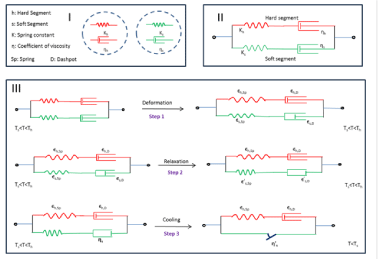
Figure 4: (I) Spring and dashpot elements to represent the hard and soft segment of the memory polymer network; (II) A viscoelastic model to represent memory
polymer; (III) Description of stress control response of the memory network using the model.
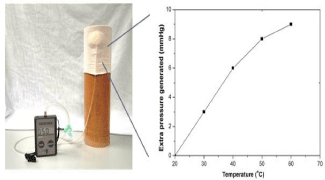
Figure 5: Potential of memory fabric to allow pressure change by temperature
activation.
The overall polymer network including hard and soft segments could be represented by two Maxwell’s model (linear combination of one spring and dashpot) arranged parallel to each other [18]. The response of spring and dashpot of both the Maxwell’s branch is different, depends on the allowable flexibility of the molecular chains in the respective region. In the step 1, i.e. stretching to a constant extension at high temperature (Ts< T <Th), the value of spring constant and dashpot of the soft segments are low, so the applied extension is consumed by both spring and dashpot elements, while in the hard segment (which is glassy in this temperature range) only the spring is extended as shown in Figure 4(III). In the step 2, which is relaxation under constraint, the dashpot of the soft segment remains active causing the decrease of the elastic stress of the spring in the branch. After sufficient time, the stress level becomes saturated as observed (Figure 2(I)). The polymer chains in the soft segments rearranged to relaxed state by releasing all stress while the stress in the hard segment remains intact and responsible for overall stress in the polymer. In the step 3, i.e., cooling to lower temperature (T <Ts), the polymer starts to solidify due to chain crystallization or verification which results in total stress freezing of the entire polymer. For the stress activation, the temperature is further increased to allow phase transition to release the stored stress.
Application of stress memory
This function of stress control of the memory polymer can be further utilized in the medical compression therapy to achieve the pressure control by compression products such as bandages, stockings, etc., used for the treatment of chronic venous disorders such as venous ulcers, oedema, varicose veins, etc [19-21]. The interface pressure exerted by a bandage fabric to the affected limb section depends on the internal stress developed in the fabric under wrapped position [22,23]. If the fabric provides stress control ability, then it would be possible to change pressure to different levels without changing the product. This will significantly reduce time and money as there will be no need for rewrapping or replacing the compression product. As a real example of stress control application, the pressure alteration by a tubular memory fabric is shown in Figure 5. The fabric was developed by integrating memory filaments in the structure. Because of memory filaments, it is possible to change the stress in the fabric structure by external temperature variation, and thereby pressure control is possible directly on the limb. At this moment, there exist several challenges in the development of optimum stocking using memory polymer as a credible compression product. Although the shape of a human leg is not cylindrical, so the customized size of the memory stocking is needed for real application. This could be achieved by changing machine parameters on the circular knitting machine to change the diameter of the fabric along its length. Such memory stocking would not only provide static compression but also could allow dynamic compression if needed during the course of the treatment. The other challenge is the activation of the product on the real leg. Future research can be done on the development of flexible and simple heating system that could be integrated with the memory stocking for programmed activation. It is envisioned that such smart fabrics could revolutionize the compression treatment with providing multi-functional benefits such as controlling the pressure level, achieving dynamic pressure or massage effect and providing necessary heating therapy for the efficient treatment practice.
Conclusion
Stress control is a novel function that could be achieved in smart textile by incorporating memory filaments in the fabric structure. This function allows alternating the stress level in the material by external stimulus. Memory polymers, such as segmented polyurethane, shows the freezing of stress in the polymer network by a suitable programming process. The freezed stress can be further recovered by external stimulus, e.g. heat, and different stress magnitude can be programmed in the polymer by controlling temperature and strain. The mechanism of stress control can be explained by simple viscoelastic model using spring and dashpot elements. Such novel function can be very useful in providing functional compression therapy using memory fabric to permit interface pressure control in the wrapped position. The research on stress control in textile is comparatively new and more future study need to conduct to analyze the response of different memory textile structures and to find their application potentials in other areas including massage devices, actuators, mattresses, pressure garments, etc.
References
- Russew MM, Hecht S. Photoswitches: From Molecules to Materials. Advance Materials. 2010; 22: 3348-3360.
- Mondal S. Phase change materials for smart textiles - An overview. Applied Thermal Engineering. 2008; 28: 1536-1550.
- Liu C, Qin H, Mather PT. Review of progress in shape-memory polymers. Journal of Material Chemistry. 2007; 17: 1543-1558.
- Ma ML, Mao Y, Gupta M, Gleason KK, Rutledge GC. Superhydrophobic fabrics produced by electrospinning and chemical vapor deposition. Macromolecules. 2005; 38: 9742-9748.
- Yang W, Li ZM, Shi W, Xie BH, Yang MB. On auxetic materials. Journal of Material Sciences. 2004; 39: 3269-3279.
- Liu ZF, Fang S, Moura FA, Ding JN, Jiang N, Di J, et al. Hierarchically buckled sheath-core fibers for superelastic electronics, sensors, and muscles. Science. 2015; 349: 400-404.
- Hu JL, Kumar B, Narayan HK. Stress Memory Polymers. Journal of Polymer Science, Part B: Polymer Physics. 2015; 53: 893-898.
- Wang AQ, Li GQ. Stress memory of a thermoset shape memory polymer. Journal of Applied Polymer Science. 2015; 132.
- Zhao Q, Qi HJ, Xie T. Recent progress in shape memory polymer: New behavior, enabling materials, and mechanistic understanding. Progress in Polymer Science. 2015; 49-50: 79-120.
- Kumar B, Hu JL, Pan N. Smart medical stocking using memory polymer for chronic venous disorders. Biomaterials. 2016; 75.
- Kumar B, Hu J, Pan N, Narayan HK. A smart orthopedic compression device based on a polymeric stress memory actuator. Materials and Design. 2016; 97: 222-229.
- Kumar B, Hu J, Pan N. Memory bandage for functional compression management for venous ulcers. Fibers. 2016; 4.
- Kumar B, Das A, Alagirusamy R. Study of the effect of composition and construction of material on sub-bandage pressure during dynamic loading of a limb in vitro. Biorheology. 2013; 50: 83-94.
- Kumar B, Das A, Alagirusamy R. An approach to examine dynamic behavior of medical compression bandage. The Journal of Textile Institute. 2013; 104: 521-529.
- Das A, Kumar B, Mittal T, Singh M, Prajapati S. Pressure profiling of compression bandages by a computerized instrument. Indian Journal of Fibre & Textile Research. 2012; 37: 114-119.
- Small W, Singhal P, Wilson TS, Maitland DJ. Biomedical applications of thermally activated shape memory polymers. Journal of Material Chemistry. 2010; 20: 3356-3366.
- Liu YP, Gall K, Dunn ML, Greenberg AR, Diani J. Thermomechanics of shape memory polymers: Uniaxial experiments and constitutive modeling. International Journal of Plasticity. 2006; 22: 279-313.
- Lin JR, Chen LW. Shape-memorized crosslinked ester-type polyurethane and its mechanical viscoelastic model. Journal of Applied Polymer Science. 1999; 73:1305-1319.
- Partsch H. Compression therapy in leg ulcers. Reviews in Vascular Medicine. 2013; 1: 9-14.
- Mosti G, Picerni P, Partsch H. Compression stockings with moderate pressure are able to reduce chronic leg oedema. Phlebology. 2012; 27: 289-296.
- Partsch H, Clark M, Mosti G, Steinlechner E, Schuren J, Abel M, et al. Classification of compression bandages: Practical aspects. Dermatologic Surgery. 2008; 34: 600-609.
- Kumar B, Das A, Alagirusamy R. Effect of material and structure of compression bandage on interface pressure variation over time. Phlebology. 2013; 29: 376-385.
- Kumar B, Das A, Alagirusamy R. Study of the effect of composition and construction of material on sub-bandage pressure during dynamic loading of a limb in vitro. Biorheology. 2012; 50: 83-94.